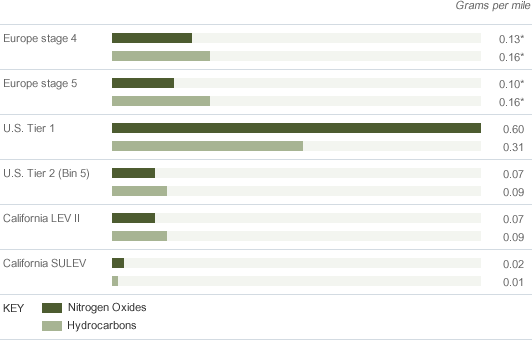Toolbox
Non-CO2 Tailpipe Emissions
Vehicle smog-forming emissions result from the incomplete combustion of fuels, impurities in fuels, and the high-temperature oxidation of atmospheric nitrogen during the fuel combustion process. Regulated smog-forming tailpipe emissions include hydrocarbons, nitrogen oxides, carbon monoxide and particulate matter. These emissions are regulated in the United States by the Environmental Protection Agency under the Clean Air Act.
United States
In the United States, Ford completed the phase-in of the world's most comprehensive set of vehicle emissions requirements: the EPA's Tier 2 regulations. Tier 2 was fully phased in with the 2009 model year.
The Tier 2 program began with the 2004 model year. It coordinates the introduction of cleaner fuels with more stringent vehicle tailpipe emissions standards in order to achieve near-zero non-CO2 tailpipe emissions from cars and light trucks. These regulations significantly reduce targeted vehicle emissions, including nitrogen oxides and non-methane organic gases, to help reduce the formation of ozone and particulate matter. The Tier 2 regulations apply to all passenger cars, light trucks and medium-duty passenger vehicles.
The comprehensive Tier 2 emissions program was designed specifically to address national air-quality issues in aggregate and includes targeted improvements in vehicle fuels. Because of this comprehensive approach, the Tier 2 program is more cost-effective and flexible than the state of California's program.
The results from the EPA's mobile source control programs, including the Tier 2 program, are impressive. The integrated and systematic approach has enabled significant reductions in smog-forming tailpipe emissions from our vehicles. By meeting these regulations, Ford has eliminated nearly 32 million pounds of smog-forming emissions from our light-duty fleet over the 2004 to 2009 model years. The EPA estimates that this program will reduce oxides of nitrogen emissions (from all relevant mobile sources) by at least 1.2 million tons by 2010.
For the California market, Ford is required to meet the state's stringent Low Emission Vehicle II (LEVII) emissions requirements for light-duty vehicles. Under the LEVII program, manufacturers are effectively required to produce a number of Partial Zero Emission Vehicles (PZEVs). A PZEV is associated with virtually zero vehicle emissions. Strictly speaking, PZEV vehicles are required to:
- meet California's Super Ultra-Low Emission Vehicle exhaust emissions standard (SULEVII),
- produce zero fuel system evaporative emissions, and
- be emissions compliant for a full useful life of 150,000 miles.
Ford's 2009 model year PZEV products included the Ford Focus, Fusion Hybrid and Escape Hybrid; the Mercury Milan, Mariner Hybrid and Sable; and the Volvo S40 and V50. For the 2010 model year, we will be offering a PZEV version of the Ford Focus; the hybrid versions of the 2010 Ford Fusion, Mercury Milan and the Lincoln MKZ will also meet the PZEV requirements.
To focus our resources most effectively in these difficult economic times, we have targeted an expanded role for technologies such as EcoBoost™ that deliver fuel-efficiency and emission benefits across our entire U.S. vehicle lineup. While introducing these new technologies, we are maintaining our commitment to the environment through the PZEV-compliant versions of products we make especially for the California market.
Information about the emissions performance of all Ford vehicles sold in the United States can be found at the EPA's Green Vehicles site.
Europe
Since 1990, non-CO2 tailpipe emissions from Ford vehicles sold in Europe have been reduced by up to 90 percent via the development of improved engine technologies (specifically diesel engines) and high-tech exhaust gas treatment devices. Ford of Europe has introduced diesel particulate filter systems on an increasing number of its new vehicles; we also have been installing these filter systems on older diesel-powered Ford vehicles, for owners who are interested.
Further air-quality improvements have been generated as we have introduced vehicles equipped with technology to meet the more-stringent Euro 4 and 5 emissions standards. All of our new passenger cars registered as of January 1, 2006, and all light-duty vehicles registered as of January 1, 2007, comply with the Euro 4 standard. In 2009, we started to introduce vehicles complying with Euro 5, which requires further reductions in nitrogen oxide (NOx) emissions and will be mandatory for all new vehicles registered from January 2011 onwards.
Emissions Regulations in the United States and Europe

| Nitrogen Oxides | Hydrocarbons | |
|---|---|---|
| Europe stage 4 | 0.13* | 0.16* |
| Europe stage 5 | 0.10* | 0.16* |
| U.S. Tier 1 | 0.60 | 0.31 |
| U.S. Tier 2 (Bin 5) | 0.07 | 0.09 |
| California LEV II | 0.07 | 0.09 |
| California SULEV | 0.02 | 0.01 |
* Standard for vehicles using gasoline as a fuel